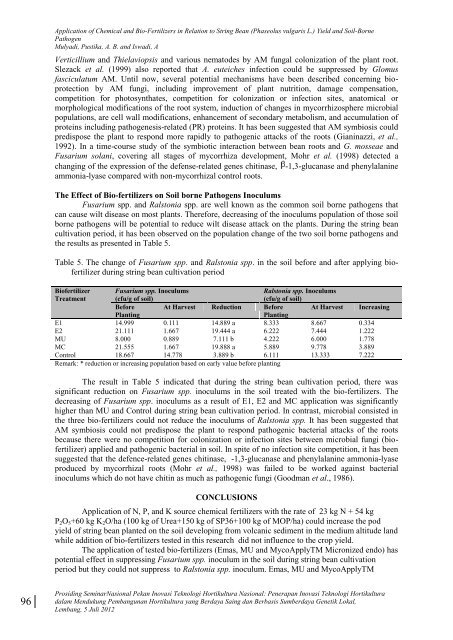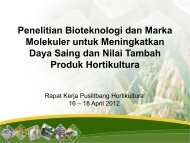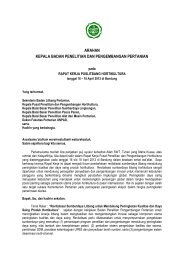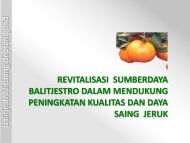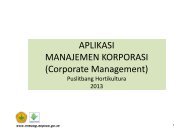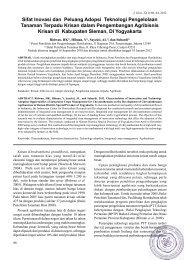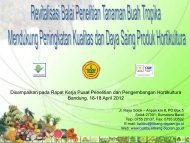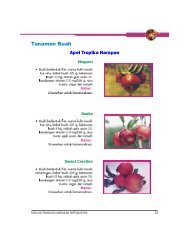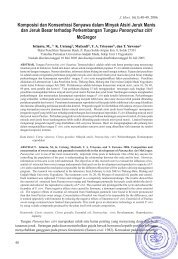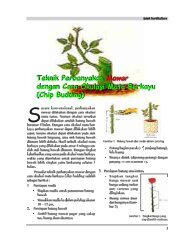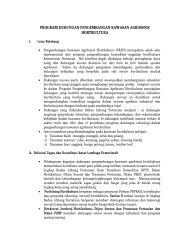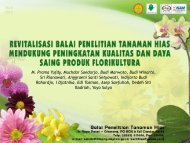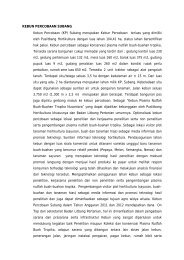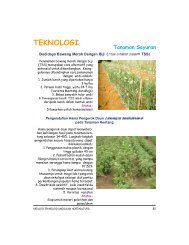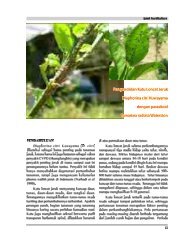- Page 1:
c BUKU 2
- Page 5 and 6:
Kata Pengantar KATA PENGANTAR Denga
- Page 7 and 8:
DAFTAR ISI Bagian 1. Pemuliaan dan
- Page 9 and 10:
terhadap Iradiasi Gamma (Indarwatmi
- Page 11 and 12:
BAGIAN 1. PEMULIAAN DAN TEKNOLOGI B
- Page 13 and 14:
Seleksi Delapan Progeni Kentang Tah
- Page 15 and 16:
Seleksi Delapan Progeni Kentang Tah
- Page 17 and 18:
Seleksi Delapan Progeni Kentang Tah
- Page 19 and 20:
Uji Daya Hasil 11 Galur Bawang Mera
- Page 21 and 22:
Uji Daya Hasil 11 Galur Bawang Mera
- Page 23 and 24:
Uji Daya Hasil 11 Galur Bawang Mera
- Page 25 and 26:
Uji Daya Hasil 11 Galur Bawang Mera
- Page 27 and 28:
Studi Persilangan Tiga Varietas Str
- Page 29 and 30:
Studi Persilangan Tiga Varietas Str
- Page 31 and 32:
Studi Persilangan Tiga Varietas Str
- Page 33 and 34:
Studi Persilangan Tiga Varietas Str
- Page 35 and 36:
Seleksi Galur Kentang Hasil Persila
- Page 37 and 38:
Seleksi Galur Kentang Hasil Persila
- Page 39 and 40:
Seleksi Galur Kentang Hasil Persila
- Page 41 and 42:
Seleksi Galur Kentang Hasil Persila
- Page 43 and 44:
Evaluasi Daya Hasil 4 Varietas Stro
- Page 45 and 46:
Evaluasi Daya Hasil 4 Varietas Stro
- Page 47 and 48:
Evaluasi Daya Hasil 4 Varietas Stro
- Page 49 and 50:
Induksi Pembentukan Embrio Somatik
- Page 51 and 52:
Induksi Pembentukan Embrio Somatik
- Page 53 and 54:
Induksi Pembentukan Embrio Somatik
- Page 55 and 56: Pemberian BAP, Kinetin dan 2-iP pad
- Page 57 and 58: Pemberian BAP, Kinetin dan 2-iP pad
- Page 59 and 60: Keragaan Dua Aksesi Rosela (Hibicus
- Page 61 and 62: Keragaan Dua Aksesi Rosela (Hibicus
- Page 63 and 64: Keragaan Dua Aksesi Rosela (Hibicus
- Page 65 and 66: Perakitan Varietas Unggul Baru Pepa
- Page 67 and 68: Perakitan Varietas Unggul Baru Pepa
- Page 69 and 70: Perakitan Varietas Unggul Baru Pepa
- Page 71 and 72: Perakitan Varietas Unggul Baru Pepa
- Page 73 and 74: Inisiasi Kultur Endosperm Durian Ku
- Page 75 and 76: Inisiasi Kultur Endosperm Durian Ku
- Page 77 and 78: Evaluasi Stabilitas Calon Varietas
- Page 79 and 80: Evaluasi Stabilitas Calon Varietas
- Page 81 and 82: Pengaruh Varietas terhadap Multipli
- Page 83 and 84: Pengaruh Varietas terhadap Multipli
- Page 85 and 86: Pengaruh Varietas terhadap Multipli
- Page 87 and 88: Pengaruh Varietas terhadap Multipli
- Page 89 and 90: Pengenalan dan Evaluasi Stabilitas
- Page 91 and 92: Pengenalan dan Evaluasi Stabilitas
- Page 93 and 94: BAGIAN 2. FISIOLOGI DAN AGRONOMI Pr
- Page 95 and 96: Yield Performance of Applying Cropp
- Page 97 and 98: Yield Performance of Applying Cropp
- Page 99 and 100: Yield Performance of Applying Cropp
- Page 101 and 102: Application of Chemical and Bio-Fer
- Page 103 and 104: Application of Chemical and Bio-Fer
- Page 105: Application of Chemical and Bio-Fer
- Page 109 and 110: Pengkajian Penggunaan Pupuk Organik
- Page 111 and 112: Pengkajian Penggunaan Pupuk Organik
- Page 113 and 114: Pengkajian Penggunaan Pupuk Organik
- Page 115 and 116: Pengkajian Penggunaan Pupuk Organik
- Page 117 and 118: Pola Pertumbuhan 3 Aksesi Kangkung
- Page 119 and 120: Pola Pertumbuhan 3 Aksesi Kangkung
- Page 121 and 122: Pola Pertumbuhan 3 Aksesi Kangkung
- Page 123 and 124: TKD TKM TKK TPKK TKD TKD TKM TKM TK
- Page 125 and 126: Pola Pertumbuhan 3 Aksesi Kangkung
- Page 127 and 128: Deskripsi Kesuburan Beberapa Lahan
- Page 129 and 130: Deskripsi Kesuburan Beberapa Lahan
- Page 131 and 132: Pemanfaatan Pupuk Fosfat dan Pengai
- Page 133 and 134: Pemanfaatan Pupuk Fosfat dan Pengai
- Page 135 and 136: Respon Adaptasi Gendola (Basella al
- Page 137 and 138: Respon Adaptasi Gendola (Basella al
- Page 139 and 140: Respon Adaptasi Gendola (Basella al
- Page 141 and 142: Respon Adaptasi Gendola (Basella al
- Page 143 and 144: Respon Adaptasi Gendola (Basella al
- Page 145 and 146: Peluang Pengembangan Sayuran Menuju
- Page 147 and 148: Peluang Pengembangan Sayuran Menuju
- Page 149 and 150: Peluang Pengembangan Sayuran Menuju
- Page 151 and 152: Pengkajian Efisiensi Pemakaian Air
- Page 153 and 154: Persentase kehilangan hasil mm Peng
- Page 155 and 156: Pengkajian Efisiensi Pemakaian Air
- Page 157 and 158:
Pengkajian Efisiensi Pemakaian Air
- Page 159 and 160:
Uji Adaptasi Beberapa Klon Kentang
- Page 161 and 162:
Uji Adaptasi Beberapa Klon Kentang
- Page 163 and 164:
Uji Adaptasi Beberapa Klon Kentang
- Page 165 and 166:
Uji Adaptasi Beberapa Klon Kentang
- Page 167 and 168:
Kajian Penerapan Teknologi Berbasis
- Page 169 and 170:
Kajian Penerapan Teknologi Berbasis
- Page 171 and 172:
Kajian Penerapan Teknologi Berbasis
- Page 173 and 174:
Sistem Irigasi Berbahan Gerabah pad
- Page 175 and 176:
Sistem Irigasi Berbahan Gerabah pad
- Page 177 and 178:
Sistem Irigasi Berbahan Gerabah pad
- Page 179 and 180:
Tingkat Serapan NPK 6 Varietas Bata
- Page 181 and 182:
Tingkat Serapan NPK 6 Varietas Bata
- Page 183 and 184:
Tingkat Serapan NPK 6 Varietas Bata
- Page 185 and 186:
Penambahan Pupuk K dalam Upaya Meni
- Page 187 and 188:
Penambahan Pupuk K dalam Upaya Meni
- Page 189 and 190:
Penambahan Pupuk K dalam Upaya Meni
- Page 191 and 192:
Pengaruh Media Tumbuh dan Pemupukan
- Page 193 and 194:
Pengaruh Media Tumbuh dan Pemupukan
- Page 195 and 196:
Pengaruh Media Tumbuh dan Pemupukan
- Page 197 and 198:
Pengaruh Media Tumbuh dan Pemupukan
- Page 199 and 200:
Aspek Ekonomi Pengendalian Ramah Li
- Page 201 and 202:
Aspek Ekonomi Pengendalian Ramah Li
- Page 203 and 204:
Aspek Ekonomi Pengendalian Ramah Li
- Page 205 and 206:
Aspek Ekonomi Pengendalian Ramah Li
- Page 207 and 208:
Validasi Metode Deteksi Bakteri Xan
- Page 209 and 210:
Validasi Metode Deteksi Bakteri Xan
- Page 211 and 212:
Validasi Metode Deteksi Bakteri Xan
- Page 213 and 214:
Solarisasu Tanah untuk Menurunkan P
- Page 215 and 216:
Solarisasu Tanah untuk Menurunkan P
- Page 217 and 218:
Solarisasu Tanah untuk Menurunkan P
- Page 219 and 220:
Kelimpahan Arthropoda Tanah dan Tin
- Page 221 and 222:
Kelimpahan Arthropoda Tanah dan Tin
- Page 223 and 224:
Kelimpahan Arthropoda Tanah dan Tin
- Page 225 and 226:
Kelimpahan Arthropoda Tanah dan Tin
- Page 227 and 228:
Pemakaian Pestisida Karbamat dan Re
- Page 229 and 230:
Residu Pestisida Organoklorin pada
- Page 231 and 232:
Residu Pestisida Organoklorin pada
- Page 233 and 234:
Residu Pestisida Organoklorin pada
- Page 235 and 236:
Residu Pestisida Organoklorin pada
- Page 237 and 238:
Identifikasi Jamur Patogen pada Tan
- Page 239 and 240:
Identifikasi Jamur Patogen pada Tan
- Page 241 and 242:
Identifikasi Jamur Patogen pada Tan
- Page 243 and 244:
Identifikasi Jamur Patogen pada Tan
- Page 245 and 246:
Identifikasi Jamur Patogen pada Tan
- Page 247 and 248:
Identifikasi Jamur Patogen pada Tan
- Page 249 and 250:
Uji Formulasi Vesicular Arbuscular
- Page 251 and 252:
Uji Formulasi Vesicular Arbuscular
- Page 253 and 254:
Uji Formulasi Vesicular Arbuscular
- Page 255 and 256:
Uji Formulasi Vesicular Arbuscular
- Page 257 and 258:
Uji Formulasi Vesicular Arbuscular
- Page 259 and 260:
Seleksi Formulasi Media Cair bagi P
- Page 261 and 262:
Seleksi Formulasi Media Cair bagi P
- Page 263 and 264:
Seleksi Formulasi Media Cair bagi P
- Page 265 and 266:
Seleksi Formulasi Media Cair bagi P
- Page 267 and 268:
Seleksi Formulasi Media Cair bagi P
- Page 269 and 270:
Studi Biologi Kutu Sisik Lepidosaph
- Page 271 and 272:
Studi Biologi Kutu Sisik Lepidosaph
- Page 273 and 274:
Studi Biologi Kutu Sisik Lepidosaph
- Page 275 and 276:
Studi Biologi Kutu Sisik Lepidosaph
- Page 277 and 278:
Studi Biologi Kutu Sisik Lepidosaph
- Page 279 and 280:
Ketahanan Kutu Putih Dysmicoccus ne
- Page 281 and 282:
Ketahanan Kutu Putih Dysmicoccus ne
- Page 283 and 284:
Ketahanan Kutu Putih Dysmicoccus ne
- Page 285 and 286:
Control of Moler Disease (Fusarium
- Page 287 and 288:
Plant Height (cm) Control of Moler
- Page 289 and 290:
Amount of seed lot (seeds) Control
- Page 291 and 292:
Pengaruh Pengendalian Hayati terhad
- Page 293 and 294:
Pengaruh Pengendalian Hayati terhad
- Page 295 and 296:
Pengaruh Pengendalian Hayati terhad
- Page 297 and 298:
Pengaruh Pengendalian Hayati terhad
- Page 299 and 300:
Studi Pengendalian Hayati Penyakit
- Page 301 and 302:
Studi Pengendalian Hayati Penyakit
- Page 303 and 304:
Studi Pengendalian Hayati Penyakit
- Page 305 and 306:
Studi Pengendalian Hayati Penyakit
- Page 307 and 308:
Studi Pengendalian Hayati Penyakit
- Page 309 and 310:
Deteksi dan Identifikasi Chrysanthe
- Page 311 and 312:
Deteksi dan Identifikasi Chrysanthe
- Page 313 and 314:
Deteksi dan Identifikasi Chrysanthe
- Page 315 and 316:
Deteksi dan Identifikasi Chrysanthe
- Page 317 and 318:
Deteksi dan Identifikasi Chrysanthe
- Page 319 and 320:
BAGIAN 4. PASCAPANEN Prosiding Semi
- Page 321 and 322:
Pengaruh Larutan Perendaman dan Jen
- Page 323 and 324:
Pengaruh Larutan Perendaman dan Jen
- Page 325 and 326:
Pengaruh Larutan Perendaman dan Jen
- Page 327 and 328:
Stabilitas Warna Saribuah Belimbing
- Page 329 and 330:
Stabilitas Warna Saribuah Belimbing
- Page 331 and 332:
Stabilitas Warna Saribuah Belimbing
- Page 333 and 334:
Stabilitas Warna Saribuah Belimbing
- Page 335 and 336:
Skala hedonik Skala hedonik Stabili
- Page 337 and 338:
Penggunaan Air Kapur (CaCo 3 ) dan
- Page 339 and 340:
Penggunaan Air Kapur (CaCo 3 ) dan
- Page 341 and 342:
Penggunaan Air Kapur (CaCo 3 ) dan
- Page 343 and 344:
Penggunaan Air Kapur (CaCo 3 ) dan
- Page 345 and 346:
Kharakteristik Beberapa Jenis Buah
- Page 347 and 348:
Kharakteristik Beberapa Jenis Buah
- Page 349 and 350:
Kharakteristik Beberapa Jenis Buah
- Page 351 and 352:
Teknologi Berbagai Kemasan terhadap
- Page 353 and 354:
Teknologi Berbagai Kemasan terhadap
- Page 355 and 356:
Teknologi Berbagai Kemasan terhadap
- Page 357 and 358:
Teknologi Berbagai Kemasan terhadap
- Page 359 and 360:
Teknologi Berbagai Kemasan terhadap
- Page 361 and 362:
Pelapisan Lilin Sebagai Upaya Mempe
- Page 363 and 364:
Pelapisan Lilin Sebagai Upaya Mempe
- Page 365 and 366:
Pelapisan Lilin Sebagai Upaya Mempe
- Page 367 and 368:
Pelapisan Lilin Sebagai Upaya Mempe
- Page 369 and 370:
Pengaruh Jenis Larutan Perendaman u
- Page 371 and 372:
Kadar Tanin (%) Pengaruh Jenis Laru
- Page 373 and 374:
Vitamin C (mg/100 g bhn) Pengaruh J
- Page 375 and 376:
Pengaruh Jenis Larutan Perendaman u
- Page 377 and 378:
Perbaikan Teknik Pengiriman Bunga K
- Page 379 and 380:
Perbaikan Teknik Pengiriman Bunga K
- Page 381 and 382:
Perbaikan Teknik Pengiriman Bunga K
- Page 383 and 384:
Perubahan kesegaran Perbaikan Tekni
- Page 385 and 386:
Perbaikan Teknik Pengiriman Bunga K
- Page 387 and 388:
Perbaikan Teknik Pengiriman Bunga K
- Page 389 and 390:
Karasteristik Fisik dan Kimia Puree
- Page 391 and 392:
Karasteristik Fisik dan Kimia Puree
- Page 393 and 394:
BAGIAN 5. SOSIAL EKONOMI Prosiding
- Page 395 and 396:
Keragaan Teknologi Jeruk Siam di Ti
- Page 397 and 398:
Keragaan Teknologi Jeruk Siam di Ti
- Page 399 and 400:
Keragaan Teknologi Jeruk Siam di Ti
- Page 401 and 402:
Peluang Pengembngan Sayuran Menuju
- Page 403 and 404:
Peluang Pengembngan Sayuran Menuju
- Page 405 and 406:
Peluang Pengembngan Sayuran Menuju
- Page 407 and 408:
Peluang Pengembngan Sayuran Menuju
- Page 409 and 410:
Respon Petani dalam Pemanfaatan Air
- Page 411 and 412:
Respon Petani dalam Pemanfaatan Air
- Page 413 and 414:
Respon Petani dalam Pemanfaatan Air
- Page 415 and 416:
Respon Petani dalam Pemanfaatan Air
- Page 417 and 418:
Identifikasi Masalah Teknologi Prod
- Page 419 and 420:
Identifikasi Masalah Teknologi Prod
- Page 421 and 422:
Identifikasi Masalah Teknologi Prod
- Page 423 and 424:
Identifikasi Masalah Teknologi Prod
- Page 425 and 426:
Peningkatan Nilai Tambah Petani Mel
- Page 427 and 428:
Peningkatan Nilai Tambah Petani Mel
- Page 429 and 430:
Peningkatan Nilai Tambah Petani Mel
- Page 431 and 432:
Peningkatan Nilai Tambah Petani Mel
- Page 433 and 434:
Peningkatan Nilai Tambah Petani Mel
- Page 435 and 436:
Karakeristik Ekonomi Produksi Anggu
- Page 437 and 438:
Karakeristik Ekonomi Produksi Anggu
- Page 439 and 440:
Karakeristik Ekonomi Produksi Anggu
- Page 441 and 442:
LAMPIRAN Prosiding SeminarNasional
- Page 443 and 444:
No Nama Peserta Instansi 43 Juniart
- Page 445:
No Nama Peserta Instansi 131 Yosi Z


